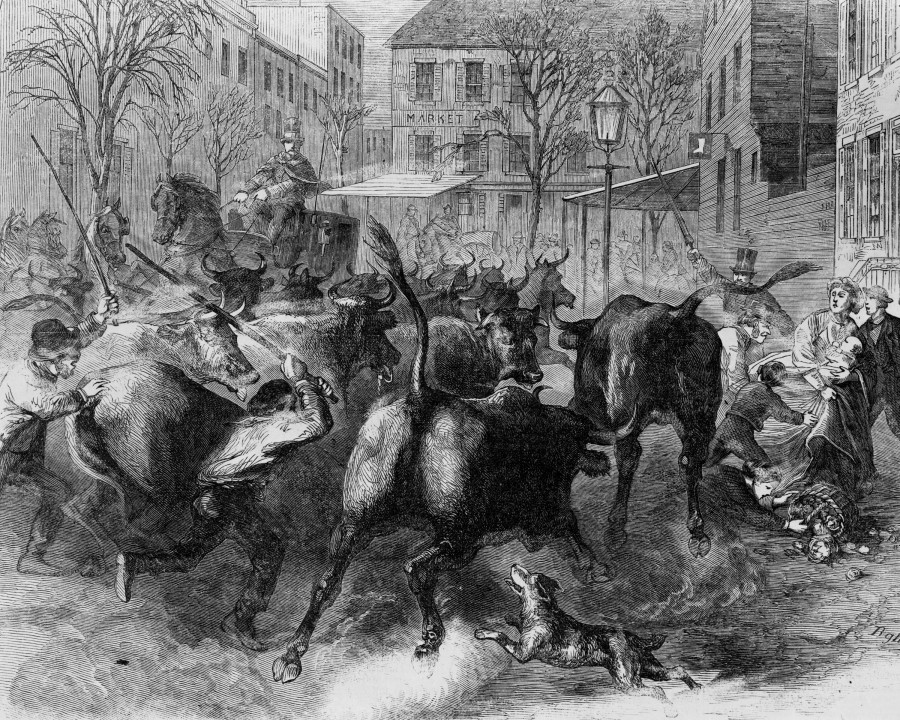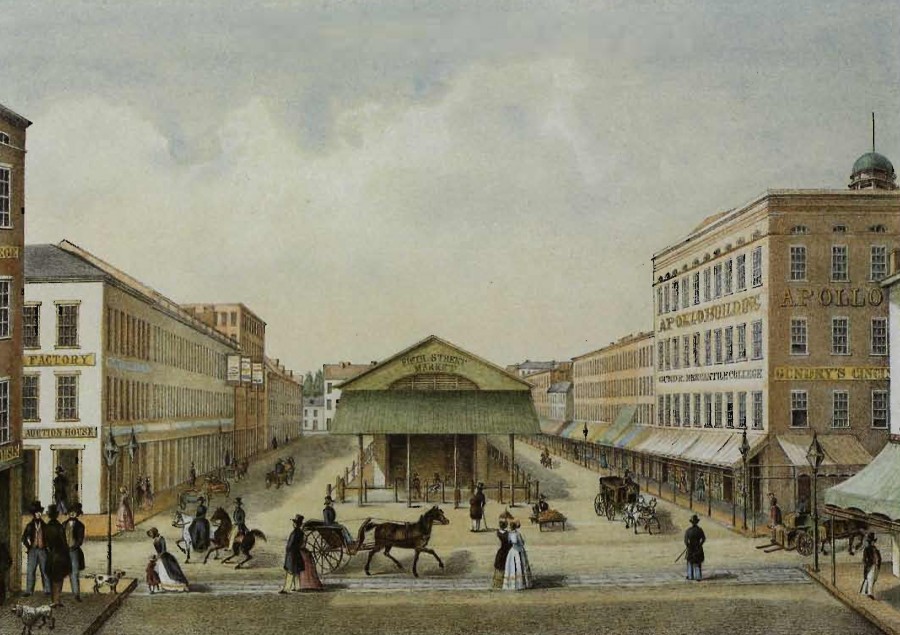In all of Cincinnati’s bizarre traditions, this one stands out. It was a parade that flourished at Christmas in the years prior to the Civil War. It was a parade of meat, a vast procession of meat “on the hoof” heading to slaughter, accompanied by marching bands and uniformed soldiers.

Illustration in Frank Leslie's illustrated newspaper, 1866 April 28
Charles Cist, essential historian of Cincinnati, describes the procession in his Sketches and Statistics of Cincinnati:
“Christmas-day is the great gala day of the butchers of Cincinnati. The parade of stall-fed meat, on that day, for several years past, has been such as to excite the admiration and astonishment of every stranger in Cincinnati-a class of persons always here in great numbers. The exhibition, this last year, has, however, greatly surpassed every previous display in this line.”
In 1850, of course, few households had any means of keeping meat for any period of time, so almost everyone bought meat from the butcher on the day it would be cooked. There was a lot of meat sold on Christmas day for that evening’s dinner.
Cincinnati had six markets in 1850: Lower, Canal, Pearl, Fifth, Sixth, and Wade. The Fifth Street Market, which occupied the space now called Fountain Square, was largely devoted to butcher shops. The “principal victualers” were Vanaken and Daniel Wunder, John Butcher (yes, we had a butcher named Butcher), J. & W. Gall and Francis and Richard Beresford. It was these merchants who created the Cincinnati Christmas Meat Parade:
“A few days prior to the return of this day of festivity, the noble animals which are to grace the stalls on Christmas eve, are paraded through the streets, decorated in fine style, and escorted through the principal streets with bands of music and attendant crowds, especially of the infantry. They are then taken to slaughter-houses, to be seen no more by the public, until cut up and distributed along the stalls of one of our principal markets.”

Queen City Heritage magazine, Volume 49, No. 3, page 26, Fall 1991; Digitized by Cincinnati History Library and Archives; Image extracted from PDF by Greg Hand
The Meat Parade included more than 500 animals, plus the hired marching bands.
“Sixty-six bullocks, of which probably three-fourths were raised and fed in Kentucky, and the residue in our own State; one hundred and twenty-five sheep, hung up whole at the edges of the stalls; three hundred and fifty pigs, displayed in rows on platforms; ten of the finest and fattest bears Missouri could produce, and a buffalo calf, weighing five hundred pounds, caught at Santa Fe, constituted the materials for this Christmas pageant.”
The animals were especially decorated for the parade. In addition, Cincinnati’s butchers went all-out to decorated their market stalls with paintings by the city’s best artists:
“No expense was spared by our butchers to give effect to this great pageant. The arches of the market-house were illuminated by chandeliers and torches, and lights of various descriptions were spread along the stalls. Over the stalls were oil portraits—in gilt frames—of Washington, Jackson, Taylor, Clay, and other public characters, together with landscape scenes. Most of these were originals, or copies by our best artists. The decorations and other items of special expense these public-spirited men were at reached in cost one thousand dollars.”
By Christmas Day, the butcher stalls of the Fifth Street Market were so overflowing with beef that cuts other than steak or prime rib were hidden behind the front counters:
“[The Fifth Street Market] comprehends sixty stalls, which, on this occasion, were filled with steaks and ribs alone, so crowded, as to do little more than display half the breadth of the meat, by the pieces overlapping each other, and affording only the platforms beneath the stall and the table, behind which the butcher stands, for the display of the rounds and other parts of the carcass. One hundred and fifty stalls would not have been too many to have been fully occupied by the meat exhibited on that day, in the manner beef is usually hung up here and in the eastern markets.”
As Charles Cist reported, in addition to fattened cattle, sheep, pigs, and the odd bison, Cincinnati gourmands went in for rarer cuts:
“Bear meat is a luxury unknown at the East, and is comparatively rare here. It is the ne plus ultra of table enjoyment.”
At that time, the quality of meat was gauged by fat content, and the Cincinnati butchers boasted meat so fat that it spoiled before sale because layers of fat insulated the butchered cuts, preventing them from cooling sufficiently, even in sub-freezing temperatures.
By noon on Christmas Day, a mountain of meat—primarily beef—had been sold and consumed:
“The beef, &c., was hung up on the stalls early upon Christmas eve, and by twelve o’clock next day, the whole stock of beef—weighing 99,000 pounds—was sold out; two-thirds of it at that hour being either preparing for the Christmas dinner, or already consumed at the Christmas breakfast.”
Mr. Cist is entirely silent on the prospect of Christmas goose, or Christmas turkey. Cincinnatians, it seems, wanted their beef, and they wanted to see it on the hoof before plunking down their hard-earned gold for a thick, fat steak.
“It may surprise an eastern epicure to learn that such beef could be afforded to customers for eight cents per pound, the price at which it was retailed, as an average.”
This article was reposted with permission from Greg Hand, editor of Cincinnati Curiosities




Facebook Comments